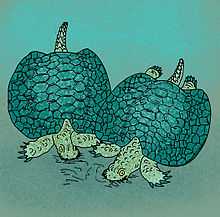Henodus
| Henodus Temporal range: Late Triassic, 228–220Ma | |
|---|---|
| | |
| Scientific classification | |
| Kingdom: | Animalia |
| Phylum: | Chordata |
| Class: | Reptilia |
| Superorder: | †Sauropterygia |
| Order: | †Placodontia |
| Family: | †Henodontidae Huene, 1936 |
| Genus: | †Henodus Huene, 1936 |
| Species: | †H. chelyops Huene, 1936 |

Henodus chelyops ("Turtle-Faced Single Tooth") was a placodont of the Late Triassic period during the early Carnian age. Fossils of Henodus chelyops were found in Tübingen, Germany. It was around 1 metre (3.3 ft) in length.
Henodus was the placodont that had the greatest (albeit superficial) resemblance to a turtle. Like turtles, it had a shell formed from a plastron on the underside and a carapace on top. The carapace extended well beyond the limbs, and was made up of individual plates of bony scutes covered by plates of horn. However, the shell was composed of many more pieces of bone than that of turtles, forming a mosaic pattern.[1] The armor was fused to its spine, and its limbs were situated in normal positions, unlike the turtle, where they are located inside the ribcage. The weak limbs of Henodus suggest it spent little, if any time on land.
Henodus chelyops also had a single tooth on each side of its mouth, though the remaining teeth were replaced by a beak. These teeth were flat to crush bottom dwelling shellfish. The head was squared-off at the front, just ahead of the eyes.
Henodus is the only placodont thus far found in non-marine deposits, suggesting it may have lived in brackish or freshwater lagoons.
References
- National Geographic, December 2005, p. 79, by Virginia Morrell
- Dixon, Dougal. The Complete Book of Dinosaurs. Hermes House, 2006
- Huene F von 1936. Henodus chelyops, ein neuer Placodontier. Palaeontographica A, 84, 99-147.
- Rieppel OC and Zanon RT 1997. The interrelationships of Placodontia. Historical Biology: Vol. 12, pp. 211-227
- Rieppel O 2000. Sauropterygia I. Placodontia, Pachypleurosauria, Nothosauroidea, Pistosauroidea. Handbuch der Paläoherpetologie, Teil 12A. München, Friedrich Pfeil.
- Rieppel, O. (2002). Feeding mechanisms in Triassic stem-group sauropterygians: the anatomy of a successful invasion of Mesozoic seas. Zoological Journal of the Linnean Society, 135, 33-63
- Cajus G. Diedrich: Fossil Middle Triassic “sea cows” – placodont reptiles as macroalgae feeders along the North-Western Tethys coastline with Pangaea and in the Germanic basin. Natural Science, Vol.3, No.1, 9-27 (2011), doi:10.4236/ns.2011.31002
- Darren Naish: Fossils explained 48. Placodonts. Blackwell Publishing Ltd, Geology Today, Vol. 20, No. 4, July–August 2004 online
| Wikimedia Commons has media related to Henodus. |
| Wikispecies has information related to: Henodontidae |
| ||||||||||||||||||||||||||||||||||||||||||||||||||||||||||||||||||||||||||||||||||||||||||||||||||||||||||||||||||||||||